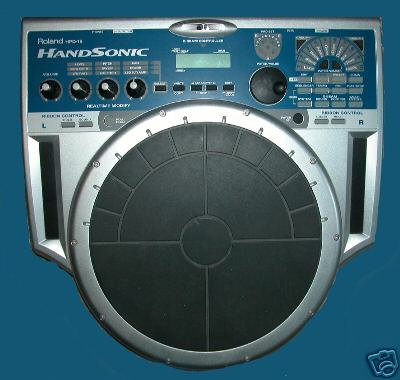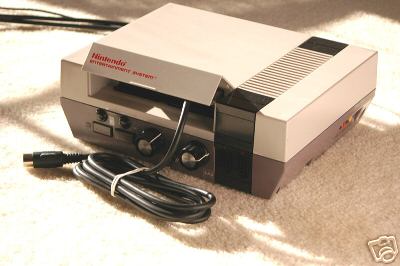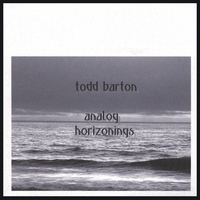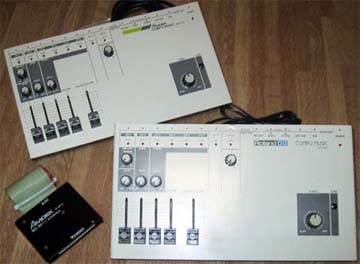
Thursday, December 28, 2006
Limor Fried and her x0xb0x Synthesizer
Revver via thewhyy27. BTW, if the video skips too much, hit play, then pause and wait for some of it to load before starting. I'm finding this to be the case with Revver videos so far.
"Limor Fried and her x0xb0x Synthesizer - a conversation between hacker/artist Limor Fried ("Lady Ada") and Joi Ito with Phil Torrone of Make Magazine. Fried talks about her popular x0xb0x synthesizer kits, and the increasing elaborate revisioning of the product that's coming from her users. With Ito and Torrone, she proposes that this is a promising model for "open source physical objects" - extending the permitted hackability of software to hardware. This is an interview from South by Southwest: Interactive, in March 2006; the camera was held by Merci Hammon, the editor was Justin Hall, and Joi Ito was the executive producer - this is part of a series of videos released online from that event under a Creative Commons Attribution 2.5 license."
Love the Open Source reference. If you think about it, "open source physical objects" goes back to... well, back to the beginning of time. Utensils anyone?
Roland HPD-15
 You might remember that I picked up a Yamaha DD55 for Christmas this year. I originally bought it to just drum out percussive rhythms. Well, I've been using the MIDI out to control my synths, and I must say it's surprisingly refreshing. I never really thought of it as an alternative MIDI controller. I've also found that I want to play it more with my hands rather than the included drum sticks. There is a "hand mode" that makes the pads more sensitive, however I haven't gotten accustomed to it yet and my fingers begin to get sore fairly quickly. Enter the Roland HPD-15. I haven't tried one yet, but it does look it would fit the bill perfectly. I'm hearing good things about it over on the Waldorf list. Title link takes you to the Roland product page for the HPD-15. I pulled the image from one of them up for auction. I'm bookmarking this one for later.
You might remember that I picked up a Yamaha DD55 for Christmas this year. I originally bought it to just drum out percussive rhythms. Well, I've been using the MIDI out to control my synths, and I must say it's surprisingly refreshing. I never really thought of it as an alternative MIDI controller. I've also found that I want to play it more with my hands rather than the included drum sticks. There is a "hand mode" that makes the pads more sensitive, however I haven't gotten accustomed to it yet and my fingers begin to get sore fairly quickly. Enter the Roland HPD-15. I haven't tried one yet, but it does look it would fit the bill perfectly. I'm hearing good things about it over on the Waldorf list. Title link takes you to the Roland product page for the HPD-15. I pulled the image from one of them up for auction. I'm bookmarking this one for later.Update: Be sure to check out the comments of this post and actually all posts for more. Huppo sent the following to the the Waldorf list where there is some discussion on the HPD-15:
" I also have a Yamaha DD-50
(predecessor to the DD-55 and quite similar) and a Roland Handsonic
HPD-10, The HPD-10 is the little brother to the HPD-15. I only had to
try the Handsonic once at a music store and immediately went home and
ordered one...it's that cool. Like many people, I am a compulsive
tabletop/steering wheel/thigh/knee drummer and the handsonic is made for
people like me. The pads, unlike the DD-50, are very sensitive to even
very light finger tapping. I haven't MIDIed it into my setup yet because
I am having too much fun with it as a standalone instrument. I got it to
add assorted percussive tidbits to my music and it works fantastic for that.
Until you play one it's hard to understand how expressive it can be. If
you play congas, for example, you can mute it with one hand and it will
respond approriately. If you slap onto the 'rim' you will get the rim
shot sound. It has aftertouch, which can be set to do all kinds of
things such as bend the sound or initiate a roll. It has a D-beam at the
top which can be set to trigger a sound or bend the notes or introduce
effects, etc. It has 64 built in 'kits' ranging from regular drum sets
(jazz, brushes, etc) to ethnic percussion like tabla and assorted
African, Asian and drums (the HPD-10 specialty) to electronic sets to
special effects groupings. You can also assemble your own sets, with all
the PCM drum sounds tunable and reassignable to any of the 10 pads, etc.
You can add two floor pedal triggers to the HPD-10 to make itmore like a
drum set, but can NOT play it with sticks.
I got it for a little over $500, new. Cheaper than the HPD-15 but not as
cheap as the DD-55 at about $150. The inportant distinction muct be made
that the Handsonic is to be played with the hands (hence the name..) and
the DD-55 is designed to be played with sticks. The pads aren't
sensitive enough to play very expressively with your hands and are much
too hard! It is fun, though, and in a pinch can be used to imitate a
drum kit since two foot triggers are included. For the money it's a
great toy and tool to have around, but I wouldn't put it in the same
class as the Handsonic offerings.
~huppo"
Roland System 100m Boxes
 Image pulled via this auction. Yep. Just the boxes are up for auction. Buy it now of $40. Should have saved your boxes. : )
Image pulled via this auction. Yep. Just the boxes are up for auction. Buy it now of $40. Should have saved your boxes. : )
NES MIDI Synth Module

Note this is the Wayfar Midines. Also note the knobs.
Click here for shots pulled via this auction.
Details:
"This auction is for a custom modified nintendo NES synthesizer which takes MIDI input from either a midi keyboard or from sequencing software (FL studio, cubase, sonar, etc), and all of the NES's sound settings are programmable via MIDI CC's (control changes). This is implemented using the lastest midiNES cartridge (1.1.0).
The sound is taken directly from the processor and is broken into two sound groups. One group consists of two channels of squarewave [which most often are used as the main 'lead' instrument in NES music] and the other group includes the triangle wave channel [often used for melodies and basslines], the noise channel [used for drums and effects], and the sample channel [used for drum samples, sound effects, etc.].
The two groups of sound have independent volume controls, and a mix on/off switch gives the option of having the two sound groups mixed (ie: all sound runs through either of the outputs), or separated (ie: drum/triangle/noises go through one output and the squarewaves go through the other).
The midiNES cartridge includes two main performance modes. . one which generates random graphic effects and one which doesn't. The start and select buttons on the front of the NES switch between these modes. [The graphics mode is very neat when the NES is hooked up to a television or monitor. . but for precise studio work, it is better to disable the graphics option.] A controller can be connected to the NES to adjust additional settings for fine studio work.
Here are the main features of the NESsynth :
- The original RCA and RF outputs on the nintendo don't really provide the cleanest signal. The sound is much better direct from the processor and through high quality 1/4" jacks.
- The volume controls and separated audio outputs will provide you with more control over your volumes and mix! [In fact, this is the only way to overcome the drawback of having the 5 channels pre-mixed.]
- The front-panel start and select buttons make the unit an entirely self-contained module! There's no need for a NES controller or monitor! You could play a live show with just a laptop, this NES, and a couple of cables!
- Most importantly, all of these modifications have been thoroughly tested and revised to ensure that the console should last a lifetime."
Previous MIDI NES posts
Rhodes Chroma
 Title link takes you to shots pulled via this auction. Apologies for not getting to this one before it ended.
Title link takes you to shots pulled via this auction. Apologies for not getting to this one before it ended.
Edd Kalehoff At the Moog Synthesizer Keyboard (Schaefer Beer)
Revver via maxkalehoff. Note this video was put up by Edd Kalehoff's son and is an excerpt from the Moog Documentary.
Todd Barton - Analog Horizonings

"a very mellow collection of ambient soundscapes featuring the EVI-2000 along with the S-P Synthacon, Buchla, Serge and JP-8"
http://cdbaby.com/cd/toddbarton
"After four decades of exploration Todd Barton is still delving deeply into the ever-expanding frontiers of musical expression: from his DNA derived Genome Music to his innovative scores for plays at the Oregon Shakespeare Festival; from performances of Zen Shakuhachi Meditation Music to avant-garde music for electronic synthesizers and computers; from performing with luminaries of jazz and poetry to lecturing on music and composition from the Middle Ages to the 21st Century.
Todd's music has been heard on NPR’s Morning Edition, Westcoast Live, and the Curve of Wonder.
Since 1979 Todd has been exploring electronic systhesis and computer-based music. His love for vintage analog synthesisers continues to this day.
Over the years Todd has collaborated with a variety of jazz musicians and poets including Anthony Braxton, Zakir Hussein, William Stafford, Ursula K. Le Guin and Lawson Fusao Inada.
analog horizonings: ambient soundscapes for vintage analog synthesizers.
all music composed, produced and performed by todd barton"
Note Todd also goes by the alias vgermuse. You can see previous posts featuring vgermuse here and one more here. You might remember him from the Steiner Parker Synthacon and Buchla 200e demos.
Roland CMU-800R MIDI Conversion Kit

Remember the CMU-800R? The biggest "problem" with it is that you need an Apple II to use it. Well, not anymore. Title link takes you to a site with info on a MIDI conversion kit for it. The site is in Japanese, however, you can find a Google translated version here .

"MIDI conversion KIT specifications
At the time of MIDI conversion remodelling, concept and the specifications were done as follows.
* At low cost and simple.
* It makes MIDI conversion KIT, the substance build in completely, decreases remodelling the substance as much as possible.
* CV, it makes 1~8ch of MIDI 1~8ch of GATE CORRESPOND.
* Melody of the built-in sound source, the base and the cord/code (4 sounds) it makes 1~6ch of MIDI CORRESPOND.
* The rhythm sound source uses MIDI10ch and the GM map.
* You do not use TEMPO [kontoru] of CMU-800.
* In order to be able to control MC-4 and TR-808 etc, DIN SYNC output is acquired. (In MIDI timing clock same period)"
via altemark.
Udpate via altemark in the comments: "Another japanese resource, seems to be an older version of the mod, not using a PIC? the page also has gif-files of the routing of the digital board among other things [link]"
PREVIOUS PAGE
NEXT PAGE
HOME













© Matrixsynth - All posts are presented here for informative, historical and educative purposes as applicable within fair use.
MATRIXSYNTH is supported by affiliate links that use cookies to track clickthroughs and sales. See the privacy policy for details.
MATRIXSYNTH - EVERYTHING SYNTH













© Matrixsynth - All posts are presented here for informative, historical and educative purposes as applicable within fair use.
MATRIXSYNTH is supported by affiliate links that use cookies to track clickthroughs and sales. See the privacy policy for details.
MATRIXSYNTH - EVERYTHING SYNTH





























